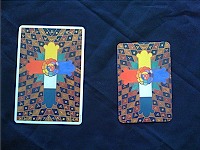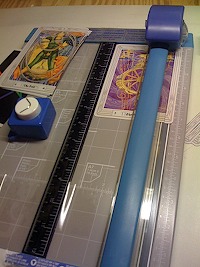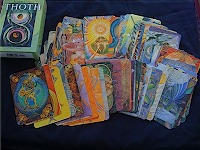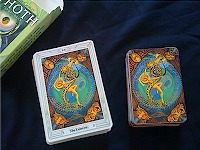By Sheri Harshberger
Have you got a deck that you would love to read with, but something about it is putting you off? For me, one of those decks is the Crowley Thoth. I love the melding of the mind of Aleister Crowley with the creative skills of Lady Frieda Harris that forms the imagery, but I don't like the keywords, nor the borders that the words appear in. It's not that I have a problem with the keywords, but the keywords make it difficult to do readings when people see "Failure" or something equally negative come up in the cards. They don't focus on the context, and they just take the keyword and let their imaginations run with it - even when the context isn't bad.
When I first decided to trim my large Crowley Thoth, I thought I was being a real rebel. Needless to say, I quickly found out that I was not the first, nor will I be the last, reader to trim or otherwise modify a deck. I found this somewhat disappointing, but also empowering.
There are many ways to pimp a deck, but for the purposes of this article, I would like to focus on trimming decks and share some of the things I have come up with or encountered when trimming a deck. Believe it or not, trimming a deck is a great way to bond with it. When I trim a deck, I take the time to look at and thank each card before I start cutting. It becomes very meditative, like coloring a mandala, or knitting.
When considering whether or not to trim a deck, consider how the illustrations are located on the card. Is the location of the illustration consistent across all the cards? Is it the same size across all the cards? Have a look at the backs of the cards. What impact will trimming have to the back? If it will affect the back design, is that important to you? How big will the finished deck size be? Can you work with that size? Even if my answers to these questions encourage trimming, I won't trim an out of print deck (OOP), especially for someone else. I like the freedom of being able to replace a deck if I screw it up! Some papers and laminates used on decks make them difficult to trim. I have had great luck with the Crowley Thoth, DruidCraft, DaVinci, Mythic, and Sacred Circle. I would not trim a Tarot of Dreams, but I know people who have.
Once you have answered these questions, you have another consideration. One thing I have noticed when trimming decks, even when the illustration seems to be placed consistently on all the cards, is that there frequently is a slight deviation from one card to the next. This comes to the forefront when trimming as you have to consider whether you want to trim to focus only on the artwork - which may leave uneven edges, or do you want to focus on making sure the edges are consistent, which, in my opinion, makes the deck look like it was created that way, but leaves the tiniest bits of border edge around the images. My personal preference is to make the edges consistent, as it looks like the deck was originally made the way you are trimming it, and also helps if you shuffle your cards like playing cards. Some people prefer the look of uneven edges as it adds an ancient, handmade look to the deck.
Once we've decided on a deck to trim, and how to trim it, we need to assemble the tools we will use. If the goal is to trim with the artwork as the focus, you’ll need:
- good scissors, rotary cutter, art knife
- straight edge
- cutting surface
If you are cutting to make the edges consistently even, you can use the tools above or use these:
- professional or heavy duty cutter
- fresh blades
- straight edges that are magnetic, or heavy duty tape
Additionally, you may want to also have handy:
- ultra super fine sandpaper
- 1/4" corner rounder
For this article, I chose a large Crowley Thoth to trim. It's by far my favorite deck to trim, and the deck that I have trimmed the most. Giving a trimmed deck is a great way to give a gift to a Tarot enthusiast who "has everything," as the odds are pretty good that they don't have a trimmed version of any particular deck, and trimming completely changes the look of the deck.
I'll be trimming to make the edges even. Some people can use scissors or a straight edge and art knife to accomplish this, but I can't. I need to use a cutting system, so I will start by positioning a card in the cutter so that the line where the border meets the artwork is lined up with the cutting blade. I use the card to place the straight edges so that the sides of the cutter and straight edges form a template I can place the cards into for cutting. Using this method requires going through the deck 4 times, once for each side being cut. I pull a few cards from the deck and slip them into the template to check the border/artwork alignment. Once I have made sure that I have things adjusted so that the maximum border is removed and the maximum artwork is maintained, I'm ready to start trimming. I always use a new blade for each deck.
This is the scariest part of the process. The first time I trimmed a deck, it took me 2 days to get up the nerve to make the first cut. After I got through that, the rest went quickly. Using the template setup saves a lot of time.
After you get through trimming the deck on one side, reset the template so that the next side of your choice can be cut. Once that is done and you've checked the alignment, you can proceed through the deck again, and so on, until all 4 sides have been trimmed.
I usually run my fingers over all the sides and corners to catch any bits of paper or slivers that may be lightly attached. If I find any, I take the ultra super fine sandpaper across the edges to remove them.
Some people like to leave the corners, but I don't, so I go through the deck one more time, inserting each corner of each card into a corner cutter to trim off the points... and voila! You have a new deck!
Your deck is now ready to be enjoyed... that is, unless you want to add some gilding to the cards or edges -- but that is a topic for another day!



